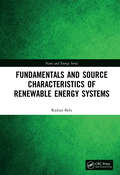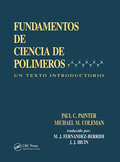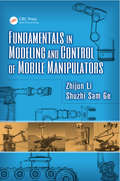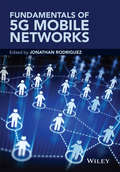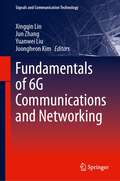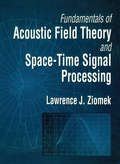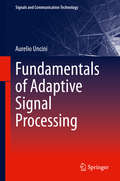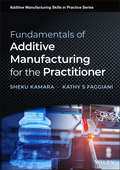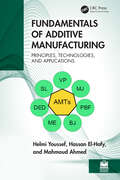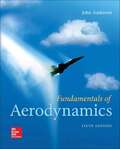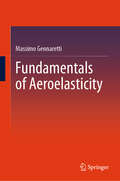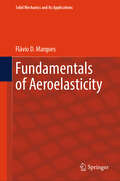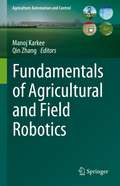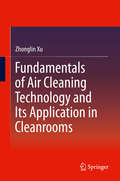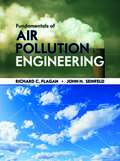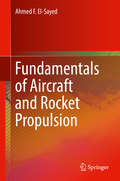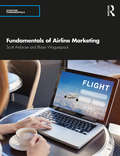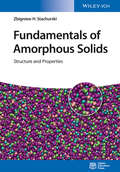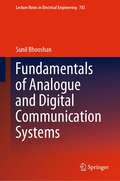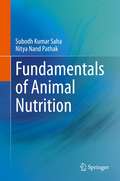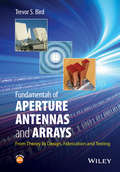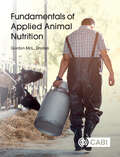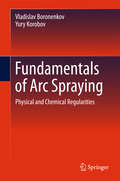- Table View
- List View
Fundamentals and Source Characteristics of Renewable Energy Systems (Nano and Energy)
by Radian BeluThis textbook is intended for an audience with little or no power engineering or renewable energy background. The book covers electric energy from alternative energy sources, including solar, wind, water, hydropower, geothermal, and ocean energy. Core issues discussed include wind and solar resource estimates and analysis, solar thermal systems, solar collectors, photovoltaics, wind turbines, geothermal energy, energy small hydropower, wave, tide and ocean energy, and characteristics of energy conversion, control, and electrical aspects. This is one of the most comprehensive textbooks for students, engineers, and professionals who study renewable energy. There are several questions and problems, presented with increasing difficulty, most of which focus on practical applications. The materials and problems are drawn from the author’s extensive experience in renewable energy analysis, assessment, design, control, and the power electronics of wind and solar energy conversion systems. Each section of the book contains several solved examples, as well as practical and advanced discussions, that instill critical thinking and apply to industrial applications. The book is divided into eight chapters and covers the most important aspects of renewable energy sources and technologies.
Fundamentals de Ciencia de Polimeros: Un Texto Introductorio
by Juan J. Iruin Maria J. Fernandez-BerridiThis is a new, basic introduction to polymer science. It is both comprehensive and readable. The authors are leading educators in this field with extensive backgrounds in industrial and academic polymer research. The text starts with a description of the types of microstructures found in polymer materials. This provides an understanding of some of the key features of the various mechanisms of homopolymerization and copolymerization which are discussed in following chapters. Also discussed in these chapters are the kinetics and statistics of polymerization, with a separate chapter on the characterization of chain structure by spectroscopic methods. The next part of the text deals with chain conformation, structure and morphology, leading to a discussion of crystallization, melting and glass transition. The discussion then moves from solid state to solution properties where solution thermodynamics is introduced. This provides the basis for discussion of the measurement of molecular weight by various solution methods. The final chapter deals with mechanical and rheological properties which are discussed from a phenomenological continuum approach and then in terms of a fundamental molecular perspective. Altogether, this new text provides a comprehensive, readable introduction to and overview of polymer science. It is well illustrated with schematics prepared for this text to help in the understanding of key concepts. It will provide a basic understanding of today's polymer science for technical and engineering personnel not already familiar with the subject, and a convenient update and overview for materials scientists.
Fundamentals in Modeling and Control of Mobile Manipulators (ISSN)
by Shuzhi Sam Ge Zhijun LiMobile manipulators combine the advantages of mobile platforms and robotic arms, extending their operational range and functionality to large spaces and remote, demanding, and/or dangerous environments. They also bring complexity and difficulty in dynamic modeling and control system design.
Fundamentals of 57Fe Mössbauer Spectrometry
by R. Justin Joseyphus Jean-Marc GrenecheThis book highlights the fundamental concepts related to 57Fe Mössbauer spectrometry, useful for graduate students and researchers. The first three chapters present essential topics related to nuclear, quantum mechanics and magnetism. The final parts of the book focus on the fundamentals and applications of 57Fe Mössbauer spectrometry. As Mössbauer spectrometry is used by students and researchers in various disciplines, this book presents the essential aspects in the relevant subject areas. The Mössbauer parameters of Fe-based alloys, ferrimagnetic, antiferromagnetic and superconducting materials, as well as applications in earth sciences, life sciences and extraterrestrial studies, are covered.
Fundamentals of 5G Mobile Networks
by Jonathan RodriguezFundamentals of 5G Mobile Networks provides an overview of the key features of the 5th Generation (5G) mobile networks, discussing the motivation for 5G and the main challenges in developing this new technology. This book provides an insight into the key areas of research that will define this new system technology paving the path towards future research and development. The book is multi-disciplinary in nature, and aims to cover a whole host of intertwined subjects that will predominantly influence the 5G landscape, including the future Internet, cloud computing, small cells and self-organizing networks (SONs), cooperative communications, dynamic spectrum management and cognitive radio, Broadcast-Broadband convergence , 5G security challenge, and green RF. This book aims to be the first of its kind towards painting a holistic perspective on 5G Mobile, allowing 5G stakeholders to capture key technology trends on different layering domains and to identify potential inter-disciplinary design aspects that need to be solved in order to deliver a 5G Mobile system that operates seamlessly.
Fundamentals of 6G Communications and Networking (Signals and Communication Technology)
by Jun Zhang Yuanwei Liu Xingqin Lin Joongheon KimThis book begins with a historical overview of the evolution of mobile technologies and addresses two key questions: why do we need 6G? and what will 6G be? The remaining chapters of this book are organized into three parts: Part I covers the foundation of an end-to-end 6G system by presenting 6G vision, driving forces, key performance indicators, and societal requirements on digital inclusion, sustainability, and intelligence. Part II presents key radio technology components for the 6G communications to deliver extreme performance, including new radio access technologies at high frequencies, joint communications and sensing, AI-driven air interface, among others. Part III describes key enablers for intelligent 6G networking, including network disaggregation, edge computing, data-driven management and orchestration, network security and trustworthiness, among others. This book is relevant to researchers, professionals, and academics working in 5G/6G and beyond.
Fundamentals of Acoustic Field Theory and Space-Time Signal Processing
by Lawrence ZiomekProviding a wealth of information on fundamental topics in the areas of linear air and underwater acoustics, as well as space-time signal processing, this book provides real-world design and analysis equations. As a consequence of the interdisciplinary nature of air and underwater acoustics, the book is divided into two parts: Acoustic Field Theory and Space-Time Signal Processing. It covers the fundamentals of acoustic wave propagation as well as the fundamentals of aperture theory, array theory, and signal processing. Starting with principles and using a consistent, mainly standard notation, this book develops, in detail, basic results that are useful in a variety of air and underwater acoustic applications. Numerous figures, examples, and problems are included.
Fundamentals of Adaptive Signal Processing
by Aurelio UnciniThis book is an accessible guide to adaptive signal processing methods that equips the reader with advanced theoretical and practical tools for the study and development of circuit structures and provides robust algorithms relevant to a wide variety of application scenarios. Examples include multimodal and multimedia communications, the biological and biomedical fields, economic models, environmental sciences, acoustics, telecommunications, remote sensing, monitoring and in general, the modeling and prediction of complex physical phenomena. The reader will learn not only how to design and implement the algorithms but also how to evaluate their performance for specific applications utilizing the tools provided. While using a simple mathematical language, the employed approach is very rigorous. The text will be of value both for research purposes and for courses of study.
Fundamentals of Additive Manufacturing for the Practitioner (Additive Manufacturing Skills in Practice. #2)
by Sheku Kamara Kathy S. FaggianiFundamentals of Additive Manufacturing for the Practitioner Discover how to shift from traditional to additive manufacturing processes with this core resource from industry leadersFundamentals of Additive Manufacturing for the Practitioner delivers a vital examination of the methods and techniques needed to transition from traditional to additive manufacturing. The book explains how traditional manufacturing work roles change as various industries move into additive manufacturing and describes the flow of the typical production process in additive manufacturing. Detailed explorations of the processes, inputs, machine and build preparation, post-processing, and best practices are included, as well as real-world examples of the principles discussed within.Every chapter includes a problems and opportunities section that prompts readers to apply the book’s techniques to their own work. Diagrams and tables are distributed liberally throughout the work to present concepts visually, and key options and decisions are highlighted to assist the reader in understanding how additive manufacturing changes traditional workflows. Readers will also benefit from the inclusion ofA thorough introduction on how to move into additive manufacturing, including the identification of a manufacturing opportunity and its characteristicsAn exploration of how to determine if additive manufacturing is the right solution, with descriptions of the origins of additive manufacturing and the current state of the technologyAn examination of the materials used in additive manufacturing, including polymers, composites, metals, plasters, and biomaterialsA discussion of choosing an additive manufacturing technology and processPerfect for mechanical engineers, manufacturing professionals, technicians, and designers new to additive manufacturing, Fundamentals of Additive Manufacturing for the Practitioner will also earn a place in the libraries of technical, vocational, and continuing education audiences seeking to improve their skills with additive manufacturing workflows.
Fundamentals of Additive Manufacturing: Principles, Technologies, and Applications
by Hassan El-Hofy Helmi Youssef Mahmoud AhmedAdditive manufacturing (AM) is a manufacturing process that has emerged as a viable technology for the production of engineering components. The aspects associated with additive manufacturing, such as less material wastage, ease of manufacturing, less human involvement, fewer tool and fixture requirements, and less post-processing, make the process sustainable for industrial use. Further, this new technology has led to highly optimized product characteristics and functional aspects. This textbook introduces the basics of this new additive manufacturing technology to individuals who will be involved in the grand spectrum of manufacturing finished products.Fundamentals of Additive Manufacturing Technology: Principles, Technologies, and Applications provides knowledge and insight into various aspects of AM and deals with the basics, categories, materials, tooling, and equipment used. It presents a classified and complete description of the most common and recently developed additive manufacturing methods with applications, solved examples, and review questions. This textbook also emphasizes the fundamentals of the process, its capabilities, typical applications, advantages, and limitations, and also discusses the challenges, needs, and general recommendations for additive manufacturing.This fundamental textbook is written specifically for undergraduates in manufacturing, mechanical, industrial, and materials engineering disciplines for courses in manufacturing technology taught in engineering colleges and institutions all over the world. It also covers the needs of production and manufacturing engineers and technologists participating in related industries. Additionally, the textbook can be used by students in other disciplines concerned with design and manufacturing, such as automotive, biomedical, and aerospace engineering.
Fundamentals of Aerodynamics
by John D. AndersonFundamentals of Aerodynamics is meant to be read. The writing style is intentionally conversational in order to make the book easier to read. The book is designed to talk to the reader; in part to be a self-teaching instrument. Learning objectives have been added to each chapter to reflect what is believed to be the most important items to learn from that particular chapter. This edition emphasizes the rich theoretical and physical background of aerodynamics, and marbles in many historical notes to provide a background as to where the aerodynamic technology comes from. Also, new with this edition, are "Integrated Work Challenges" that pertain to the chapter as a whole, and give the reader the opportunity to integrate the material in that chapter, in order to solve a "bigger picture". McGraw-Hill's Connect, is also available as an optional, add on item. Connect is the only integrated learning system that empowers students by continuously adapting to deliver precisely what they need, when they need it, how they need it, so that class time is more effective. Connect allows the professor to assign homework, quizzes, and tests easily and automatically grades and records the scores of the student's work. Problems are randomized to prevent sharing of answers an may also have a "multi-step solution" which helps move the students' learning along if they experience difficulty.
Fundamentals of Aeroelasticity
by Massimo GennarettiThis textbook provides the fundamentals of aeroelasticity, with particular attention to problems of interest to aeronautical engineering. The mathematical methods and tools applicable to the modern modeling of general aeroelastic problems are presented, discussed, and applied to fixed-wing aircraft configurations. It is composed of ten chapters divided into two parts: (I) aeroelastic modeling and analysis and (ii) mathematical tools. The six chapters that compose the first part start from the historical background of the discipline, then present the methods for coupling structural dynamics and unsteady aerodynamics for the aeroelastic modeling of the typical wing section, and then extend them to applications for twisted, tapered, swept finite-wing configurations. In this context, particular attention is paid to the presentation, interpretation, and discussion of the available unsteady sectional aerodynamic theories, both in the time and frequency domain, providing a broad scenario of the formulations that can be used for conventional and non-conventional aerodynamic/aeroelastic applications. For a modern view of aeroelasticity, a significant portion of the textbook deals with illustration and discussion of three-dimensional aerodynamic theories and computational methods for the determination of unsteady aerodynamic loads over lifting bodies in incompressible and compressible flows, as well as to the introduction and explanation of methodologies for the identification of reduced-order, state-space aerodynamic/aeroelastic operators suitable for stability (flutter) analysis and control purposes. A chapter is dedicated to the theories and approaches for aeroservoelastic modeling. In the second part of the textbook, additional chapters provide theoretical insights on topics that enrich the multidisciplinary knowledge related to widely applied methods and models for the analysis and solution of aeroelastic problems. The book serves as a reference tool for master's degree students in aeronautical/aerospace engineering, as well as researchers in the field of aeroelasticity.
Fundamentals of Aeroelasticity (Solid Mechanics and Its Applications #279)
by Flávio D. MarquesThis book delves into the fundamentals of aeroelasticity, providing a modern foundation for education and research in aeronautical engineering. It begins with a brief introduction to aeroelasticity and then explores the static stability of airfoils and wings, using elementary models to solve fluid-structure interaction problems under equilibrium conditions. The dynamics of the typical aeroelastic section are examined, including modal analysis and dynamic characterization. Analytical and numerical aerodynamic models are discussed for unsteady aerodynamics, offering tools for studying stability phenomena and calculating aeroelastic responses. The text covers aeroelastic response and stability analysis, demonstrating coupled aerodynamic models' behavior under varying parameters and predicting flutter phenomena. The dynamic aeroelasticity of wings is analyzed, presenting a time-domain simulation model to show flutter conditions and aeroelastic modes. Appendices provide insights on finite element modeling of beams, self-excited systems, and surface interpolation methods, with numerous examples for result replication, though no specific computational tools are suggested.
Fundamentals of Aerospace Navigation and Guidance
by Pierre T. Kabamba Anouck R. GirardThis text covers fundamentals used in the navigation and guidance of modern aerospace vehicles, in both atmospheric and space flight. It can be used as a textbook supporting a graduate level course on aerospace navigation and guidance, a guide for self-study, or a resource for practicing engineers and researchers. It begins with an introduction that discusses why navigation and guidance ought to be considered together and delineates the class of systems of interest in navigation and guidance. The book then presents the necessary fundamentals in deterministic and stochastic systems theory and applies them to navigation. Next, the book treats optimization and optimal control for application in optimal guidance. In the final chapter, the book introduces problems where two competing controls exercise authority over a system, leading to differential games. Fundamentals of Aerospace Navigation and Guidance features examples illustrating concepts and homework problems at the end of all chapters.
Fundamentals of Agricultural and Field Robotics (Agriculture Automation and Control)
by Qin Zhang Manoj KarkeeOver the past century, mechanization has been an important means for optimizing resource utilization, improving worker health and safety and reducing labor requirements in farming while increasing productivity and quality of 4F (Food, Fuel, Fiber, Feed). Recognizing this contribution, agricultural mechanization was considered as one of the top ten engineering achievements of 20th century by the National Academy of Engineering. Accordingly farming communities have adopted increasing level of automation and robotics to further improve the precision management of crops (including input resources), increase productivity and reduce farm labor beyond what has been possible with conventional mechanization technologies. It is more important than ever to continue to develop and adopt novel automation and robotic solutions into farming so that some of the most complex agricultural tasks, which require huge amount of seasonal labor such as fruit and vegetable harvesting, could be automated while meeting the rapidly increasing need for 4F. In addition, continual innovation in and adoption of agricultural automation and robotic technologies is essential to minimize the use of depleting resources including water, minerals and other chemicals so that sufficient amount of safe and healthy food can be produced for current generation while not compromising the potential for the future generation. This book aims at presenting the fundamental principles of various aspects of automation and robotics as they relate to production agriculture (the branch of agriculture dealing with farming operations from field preparation to seeding, to harvesting and field logistics). The building blocks of agricultural automation and robotics that are discussed in the book include sensing and machine vision, control, guidance, manipulation and end-effector technologies. The fundamentals and operating principles of these technologies are explained with examples from cutting-edge research and development currently going on around the word. This book brings together scientists, engineers, students and professionals working in these and related technologies to present their latest examples of agricultural automation and robotics research, innovation and development while explaining the fundamentals of the technology. The book, therefore, benefits those who wish to develop novel agricultural engineering solutions and/or to adopt them in the future.
Fundamentals of Air Cleaning Technology and Its Application in Cleanrooms
by Zhonglin XuFundamentals of Air Cleaning Technology and Its Application in Cleanrooms sets up the theoretical framework for cleanrooms. New ideas and methods are presented, which include the characteristic index of cleanrooms, uniform and non-uniform distribution characteristics, the minimum sampling volume, a new concept of outdoor air conditioning and the fundamentals of leakage-preventing layers. Written by an author who can look back on major scientific achievements and 50 years of experience in this field, this book offers a concise and accessible introduction to the fundamentals of air cleaning technology and its application. The work is intended for researchers, college teachers, graduates, designers, technicians and corporate R&D personnel in the field of HVAC and air cleaning technology.Zhonglin Xu is a senior research fellow at China Academy of Building Research.
Fundamentals of Air Pollution Engineering
by John H. Seinfeld Richard C. FlaganA rigorous and thorough analysis of the production of air pollutants and their control, this text is geared toward chemical and environmental engineering students. Topics include combustion, principles of aerosol behavior, theories of the removal of particulate and gaseous pollutants from effluent streams, and air pollution control strategies. 1988 edition.
Fundamentals of Aircraft and Rocket Propulsion
by Ahmed F. El-SayedThis book provides a comprehensive basics-to-advanced course in an aero-thermal science vital to the design of engines for either type of craft. The text classifies engines powering aircraft and single/multi-stage rockets, and derives performance parameters for both from basic aerodynamics and thermodynamics laws. Each type of engine is analyzed for optimum performance goals, and mission-appropriate engines selection is explained. Fundamentals of Aircraft and Rocket Propulsion provides information about and analyses of: thermodynamic cycles of shaft engines (piston, turboprop, turboshaft and propfan); jet engines (pulsejet, pulse detonation engine, ramjet, scramjet, turbojet and turbofan); chemical and non-chemical rocket engines; conceptual design of modular rocket engines (combustor, nozzle and turbopumps); and conceptual design of different modules of aero-engines in their design and off-design state. Aimed at graduate and final-year undergraduate students, this textbook provides a thorough grounding in the history and classification of both aircraft and rocket engines, important design features of all the engines detailed, and particular consideration of special aircraft such as unmanned aerial and short/vertical takeoff and landing aircraft. End-of-chapter exercises make this a valuable student resource, and the provision of a downloadable solutions manual will be of further benefit for course instructors.
Fundamentals of Airline Marketing (Aviation Fundamentals)
by Scott Ambrose Blaise WaguespackApplying fundamentals of marketing to commercial passenger air transportation, this textbook puts the emphasis on marketing principles and illustrative ways in which airlines can distinguish themselves within the highly competitive global marketplace. Fundamentals of Airline Marketing begins with a survey of current airline business strategies and the macro forces that have shaped the airline industry in the past and will continue to do so in the future. The growing importance of technology is discussed both from the perspective of better understanding customer needs and engaging more effectively with them. The central role of the "customer" is explored through the lens of modern segmentation and branding approaches. Coverage then shifts to the tactical decision areas consisting of the 4Ps—product, place, promotion, and price—in which marketers shape and execute their strategies. The book concludes with a focus on executing marketing initiatives internally through customer-facing employee groups and externally through the measurement and management of the customer experience. Fundamentals of Airline Marketing: • is an accessible textbook on the fundamentals of marketing for commercial passenger air transportation; • chronicles the marketing innovations and controversies that have been central to the historic shift in airline fortunes; • demonstrates how airline decisions fit within the fundamentals of marketing and how the marketplace is continuing to evolve; • provides a bridge between key marketing principles and their specific application to the airline industry in each chapter. This textbook is written primarily for undergraduate college students enrolled in aviation business administration programs and related courses. It will also serve as an accessible primer on airline marketing for industry professionals not presently working in marketing and for frontline airline employees seeking to learn more about marketing.
Fundamentals of Amorphous Solids: Structure and Properties
by Zbigniew H. StachurskiLong awaited, this textbook fills the gap for convincing concepts to describe amorphous solids. Adopting a unique approach, the author develops a framework that lays the foundations for a theory of amorphousness. He unravels the scientific mysteries surrounding the topic, replacing rather vague notions of amorphous materials as disordered crystalline solids with the well-founded concept of ideal amorphous solids. A classification of amorphous materials into inorganic glasses, organic glasses, glassy metallic alloys, and thin films sets the scene for the development of the model of ideal amorphous solids, based on topology- and statistics-governed rules of three-dimensional sphere packing, which leads to structures with no short, mid or long-range order. This general model is then concretized to the description of specific compounds in the four fundamental classes of amorphous solids, as well as amorphous polyethylene and poly(methyl)methacrylate, emphasizing its versatility and descriptive power. Finally, he includes example applications to indicate the abundance of amorphous materials in modern-day technology, thus illustrating the importance of a better understanding of their structure and properties. Equally ideal as supplementary reading in courses on crystallography, mineralogy, solid state physics, and materials science where amorphous materials have played only a minor role until now.
Fundamentals of Analogue and Digital Communication Systems (Lecture Notes in Electrical Engineering #785)
by Sunil BhooshanThe book covers fundamentals and basics of engineering communication theory. It presents right mix of explanation of mathematics (theory) and explanation. The book discusses both analogue communication and digital communication in details. It covers the subject of ‘classical’ engineering communication starting from the very basics of the subject to the beginning of more advanced areas. It also covers all the basic mathematics which is required to read the text. It covers a two semester course as an undergraduate text and some topics in master’s course as well.
Fundamentals of Animal Nutrition
by Subodh Kumar Saha Nitya Nand PathakThe book provides comprehensive information about the different aspects of veterinary nutrition in tropical countries.The introductory chapter discuss the importance of nutrition, feeds and feeding of balanced and optimum feeds specifically required for the sustenance of life. The second chapter, discusses briefly the history of research in animal nutrition.The book further talks about the relationship between the environment and nutrition in animals; the chemical composition of plants and animals; and the various sources of feed for animals. It provides details on the different phases of life cycle in animals, and the effect of nutrition on the performance. Various Nutrients and its importance in livestock nutritionand production has been illustrated in details. Various nutrients such as water, carbohydrate, protein, fats, vitamins, minerals etc are individually dealt in a separate chapter. The digestive system,digestion and metabolism of carbohydrates, protein and fats in ruminant and non ruminant livestock have been illustrated. A dedicated chapter fully describes the activity of enzymes which are directly involved in nutrition. Also this book deals with the harmful components of animal feed which are found mainly in the unconventional feeds. The books also provide chapters like partitioning of feed& energy and also the therapeutic and clinical nutrition which are very importantfor the under graduate & post graduate students and researchers of animal nutrition and livestock production and management. This book is useful for researchers, undergraduate and post graduate students studying veterinary sciences, animal husbandry, zoology and biochemistry.
Fundamentals of Aperture Antennas and Arrays
by Trevor S. BirdThis book is intended as an advanced text for courses in antennas, with a focus on the mature but vital background field of aperture antennas. The book is aimed at final year, MSc, PhD and Post-Doctoral students, as well as readers who are moving from academia into industry, beginning careers as wireless engineers, system designers, in R&D, or for practising engineers. It assumes the reader has undertaken an earlier course of study on Maxwell's equations, fields and waves. Some of these topics are summarised in the early few chapters in order to provide continuity and background for the remaining chapters. The aperture antennas covered include the main types of horns, reflectors and arrays as well as microstrip patches, reflectarrays and lenses. To provide more than a superficial treatment of arrays, the topic of mutual coupling is covered in greater detail than most similar books in the area. Also included is an introduction to arrays on non-planar surfaces, which is of importance for applications that involve curved surfaces such as in aerodynamics or for making aperture antennas unobtrusive. A chapter is included on some modern aperture antennas to illustrate design techniques beyond the most common types of aperture antennas described in the early chapters. This is to show where advances have recently been made and where they could be improved in the future. Also included are selected topics of a practical nature for aperture antennas, namely fabrication and measurement.
Fundamentals of Applied Animal Nutrition
by Gordon DrydenIf you have ever wondered why animals prefer some foods and not others, how poor feeding management can cause conditions such as laminitis, rumenitis or diarrhoea, or how to construct a diet to optimise animal performance and health, then this book will introduce you to the fundamentals of animal nutrition and their practical implementation. While giving a comprehensive and practical overview of the principles that underpin the design and management of farm animal feeding systems, this book: - Covers a wide range of topics from digestive function, nutrients and feed composition, to intake, feed related disorders, grazing behaviour and management, as well as how animals influence climate change and the environment. - Contains hints, tips and practical advice on animal feeding. - Includes links to the latest data on feed composition and nutrient requirements. - Is a companion book to the author's book titled Animal Nutrition Science. With its evidence-based approach and emphasis on the practical throughout, this is a valuable textbook for undergraduate and graduate animal science students studying the feeding of farm animals. It is also an essential reference for early practitioners, veterinarians, farm managers and advisers in animal feed companies.
Fundamentals of Arc Spraying
by Vladislav Boronenkov Yury KorobovThis book guides readers through the systematic analysis of Arc Spraying: one of the most widespread and important thermal spraying methods. Along the way, readers from industry and research laboratories become familiar with the features of the process and physical-chemical regulations of particles in flight, coating formation, internal coating properties, and their output parameters. The book is ideal for engineers, technicians, and scientists engaged in welding and thermal spraying and stands as an excellent reference for students interested in advanced coatings technology.
